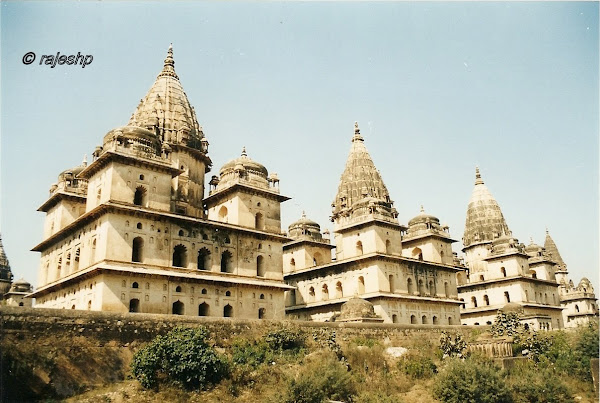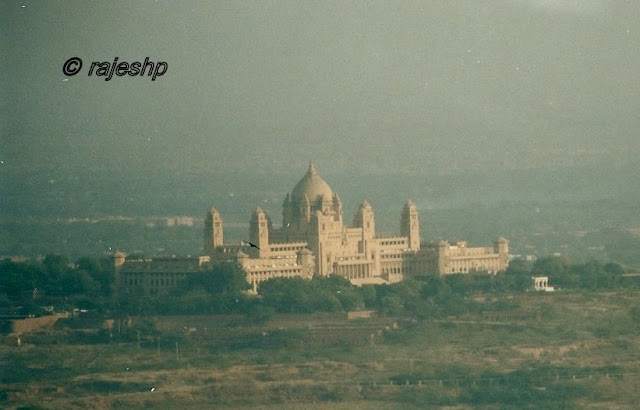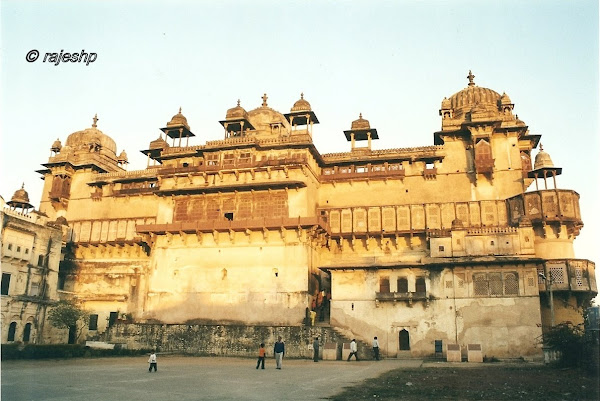In Orchha (State: Madhya Pradesh) the architecture of the 16th century temple with its soaring spires is very different from any other temple in India. It is also the only place in the country where Lord Rama is worshipped as a King.
 This temple was originally the queen's palace of the Bundela King Madhukar Shah. There is a legend associated with it. The queen being an devotee of Lord Rama had got an idol of Rama from Ayodha to be kept in a newly built temple. She was told that, once the idol is kept down for the first time in Orchha, it can not be later moved out.
This temple was originally the queen's palace of the Bundela King Madhukar Shah. There is a legend associated with it. The queen being an devotee of Lord Rama had got an idol of Rama from Ayodha to be kept in a newly built temple. She was told that, once the idol is kept down for the first time in Orchha, it can not be later moved out.
It so happened that, when queen arrived in Orchha, the new temple the Chaturbhuj Temple built for the Lord Rama was not still ready. Due to this the idol was placed in Queen's palace for the day. But, later it could not be relocated from this place. Because of this the palace was converted into a temple.
In Orchha (State: Madhya Pradesh) the cenotaphs (chhatris) of 16th century are located on the banks of Betwa river. They are basically tomb erected in honor of a person, whose remains are elsewhere.
 Here the Chhatris are elevated, dome-shaped pavilions. The architecture has elements of Hindu as well as Mughal architecture in them.
Here the Chhatris are elevated, dome-shaped pavilions. The architecture has elements of Hindu as well as Mughal architecture in them.
 The royal chattris are memorials to Bundelkhand's former rulers. One can see series of rows of pale brown weed-choked domes and spires inside a compound on the banks of Betwa river.
The royal chattris are memorials to Bundelkhand's former rulers. One can see series of rows of pale brown weed-choked domes and spires inside a compound on the banks of Betwa river.
In Orchha (State: Madhya Pradesh) the cenotaphs (chhatris) of 16th century are located on the banks of Betwa river. They are basically tomb erected in honor of a person, whose remains are elsewhere.
 Here the Chhatris of Bundela dynasty kings are elevated, dome-shaped pavilions. But this unusual cenotaph different in design from rest of the royal cenotaphs caught my attention.
Here the Chhatris of Bundela dynasty kings are elevated, dome-shaped pavilions. But this unusual cenotaph different in design from rest of the royal cenotaphs caught my attention.
During our visit to Jodhpur (State: Rajasthan) we planned to visit Umaid Bhavan Palace, after the tour of the Jodhpur fort. We reached this place at 6 p.m and the gates were closed for us. If one wishes to visit this place be here before 5 p.m. After 5 p.m the gates are closed for visitors and they are allowed nowhere near the gates.

Constructed of marble and pink sandstone this immense palace is also known as the Chhittar Palace because it uses local Chittar sandstone. Begun in 1929, it was designed by president of the British Royal Institute of Architects for Maharaja Umaid Singh and took 15 years to complete.
 This palace is outside the fort and now converted into a luxury hotel. The above snaps was taken from the fort.
This palace is outside the fort and now converted into a luxury hotel. The above snaps was taken from the fort.
Orchha (State: Madhya Pradesh) has an imposing fort, dating back to the 16th century. The Fort Complex contains magnificent palaces of the Bundela kings presenting a matchless spectacle of those times.
 One of such palace is 17th century palace, the Jehanghir Mahal. It is a three storied most impressive palace, which is a fine example of of Indo-Islamic architecture. The harmony in the construction of palace can be seen in hanging balconies, topped domes and lovely onion shaped domes around the central courtyard.
One of such palace is 17th century palace, the Jehanghir Mahal. It is a three storied most impressive palace, which is a fine example of of Indo-Islamic architecture. The harmony in the construction of palace can be seen in hanging balconies, topped domes and lovely onion shaped domes around the central courtyard.
 This palace is more airy and lighted since it has countless windows and pierced stone screens looking out over the skyline to the west. In the other direction one can see a sea of treetops and ruined temples.
This palace is more airy and lighted since it has countless windows and pierced stone screens looking out over the skyline to the west. In the other direction one can see a sea of treetops and ruined temples.
Orchha (State: Madhya Pradesh) has an imposing fort, dating back to the 16th century. The Fort Complex contains magnificent palaces of the Bundela kings presenting a matchless spectacle of those times.
 One of such palace is 17th century palace, the Jehanghir Mahal. It is a magnificent structure and grandest of all palaces in Orchha. This was built by then King Bir Singh Deo between 1605 and 1627 to commemorate the visit of Emperor Jahanghir to Orchha. It is a three storied building, which is a fine example of of Indo-Islamic architecture.
One of such palace is 17th century palace, the Jehanghir Mahal. It is a magnificent structure and grandest of all palaces in Orchha. This was built by then King Bir Singh Deo between 1605 and 1627 to commemorate the visit of Emperor Jahanghir to Orchha. It is a three storied building, which is a fine example of of Indo-Islamic architecture.
 The main entrance of the palace is east-facing facade, which is covered with turquoise tiles. The arrival of Raja was announced by the ringing of bells of the beautiful stone elephants that guards the stairway.
The main entrance of the palace is east-facing facade, which is covered with turquoise tiles. The arrival of Raja was announced by the ringing of bells of the beautiful stone elephants that guards the stairway.
 This temple was originally the queen's palace of the Bundela King Madhukar Shah. There is a legend associated with it. The queen being an devotee of Lord Rama had got an idol of Rama from Ayodha to be kept in a newly built temple. She was told that, once the idol is kept down for the first time in Orchha, it can not be later moved out.
This temple was originally the queen's palace of the Bundela King Madhukar Shah. There is a legend associated with it. The queen being an devotee of Lord Rama had got an idol of Rama from Ayodha to be kept in a newly built temple. She was told that, once the idol is kept down for the first time in Orchha, it can not be later moved out. 















